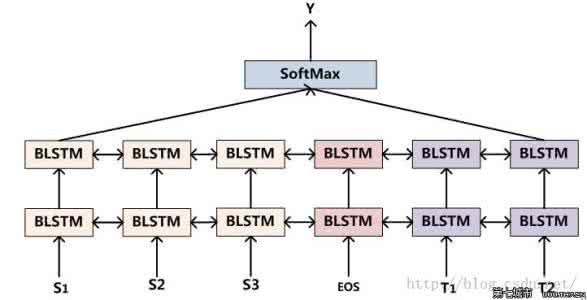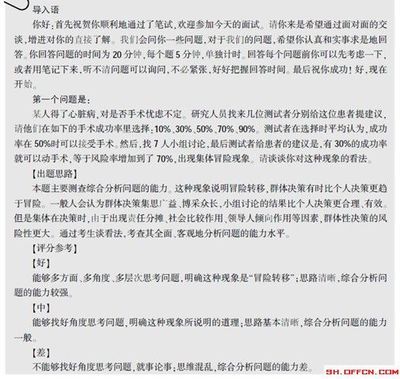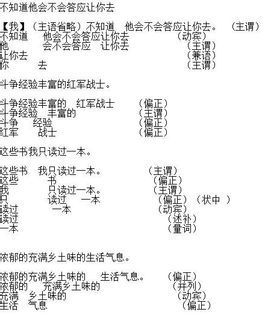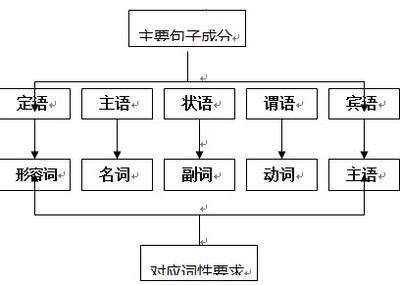结构
英文缩写
例句
常见动词
备注
主语+谓语
S+V
The boy laughed.
谓语动词均为不及物动词,后面不跟宾语,但可跟时间、地点、方式等状语。
主语+谓语+宾语
S+V+DO
He plays the violin very well.
这里的谓语动词为及物动词,后面必须跟宾语。
主语+连系动词+表语
S+V+P
She is a doctor.
be, keep, seem, look, feel, smell, sound, taste, become, grow, turn, fall, get
这里的动词都为连系动词。
主语+谓语+间接宾语+直接宾语
S+V+IO+DO
I gave her a present.
give, bring, show, pass, buy, make, tell, ask, get, teach, write, sing, lend, hand, sell, cost, pay
通常情况下,间接宾语位于直接宾语的前面,但有时根据需要,间接宾语位于直接宾语之后,这时要在间接宾语前加to或for
主语+谓语+宾语+宾语补足语
S+V+DO+OC
We call him Jack.
think, keep, make, name, call, see, hear, watch, help, let, tell, ask, paint, leave
宾语补足语部分可以为形容词,名词,不定式等形式
句子的基本句型
由主语、谓语动词、表语、宾语、宾语补足语等句子成分,按不同方式可组合成五种基本句型。
句子成分的表示方法:
S: Subject主语;
V: Verb动词;
O: Object宾语;
P: Predicative表语;
IO: Indirect Object间接宾语;
DO:Direct Object 直接宾语
OC: Object Complement宾语补足语;
◇第一种句型:主语+不及物动词(S+V)
该句型所用动词都是不及物动词,其后当然不能接宾语,但是可以用状语修饰谓语动词或整 个句子。
He runs fast in the street.
他在街上跑得飞快。
The meeting begins at nine.
会议九点开始。
◇第二种句型:主语+及物动词+宾语(S+V+DO)
该句型所用动词都是及物动词,可作宾语的有名词、代词、不定式、动名词或短语及从句。
We attended the meeting.
我们出席了那次会议。(名词作宾语)
She stopped him.
她叫住了他。(代词作宾语)
She wants to ask a question.
她要问一个问题。(不定式作宾语)
They enjoy listening to the classic music.
他们喜欢听古典音乐。(动名词作宾语)
注意:一些不及物动词之后加上介词就可以具有及物动词的功能,其后就可以接宾语了。
这一类词组有:listen to 听;look at 看;look after 照看;look for 寻找;arrive at/in 到达等。
May I turn on the light?
我可以开灯吗?
What are you looking for?
你在找什么?
◇第三种句型:主语+连系动词+表语(S+V+P)
连系动词的后面必须接表语,说明主语的情况和状态。通常可作表语的是名词或形容词。
She became a lawyer last year.
去年,她成为了一名律师。
He is honest.
他是诚实的。
It is getting colder and colder.
天气渐渐冷了。
It tastes delicious.
这好吃极了。
下列动词也作连系动词使用 :look 看起来;smell 闻起来;sound 听起来;taste 尝起来;feel 感觉;keep 保持; grow/go/get/turn变得。
◇第四种句型:主语+及物动词+间接宾语+直接宾语(S+V+IO+DO)
(1)宾语分直接宾语和间接宾语。直接宾语是及物动词的直接对象,但某些动词,除直接宾语外,还要求一个间接宾语,以表示该动词所表示的动作所及的人或物,通常由名词或代词 的宾格担任。
She gave me a ticket for that film.
她给了我一张那部电影的票。
Please pass me the salt.
请把盐递给我
(2)通常情况下,间接宾语位于直接宾语的前面,但有时根据强调需要,间接宾语位于直接宾语之后,这时要在间接宾语前加to或for。
I will bring the book(宾,直接) to you next time. (宾,间接)
(=I will bring you the book next time.)
我下次把那本书给你带来。
He promised a motorbike (宾,直接) to her. (宾,间接)
(=He promised her a motorbike.)
他答应给她买一辆摩托车。
Mother bought a new bag (宾,直宾) for him.(宾,间宾)
(=Mother bought him a new bag.)
妈妈给他买了一个新书包。
She sang several songs (宾,直宾) for them. (宾,间宾)
(=She sang them several songs.)
她为他们唱了几首歌。
Please pass (谓)the salt (宾,直接)to me. (宾,间接)
请把盐递给我。
注意:带特殊疑问词的不定式短语作直接宾语是一种很常用的形式,基本句型是:S+V+DO+疑问词+不定式
主语+及物动词+间接宾语+疑问词+不定式
She told me how to understand the article.
她告诉我怎样理解这篇文章。
They wanted to know where to solve the problem.
他们想要知道哪里能够解决这个问题。
The boy asked her why to do so.
那孩子问她为什么这么做。
I asked him which one to choose.
我问他选择哪一个。
◇第五种句型:主语+及物动词+宾语+宾语补足语(S+V+DO+OC)
(1)有些及物动词,只接一个宾语不能表达完整的意思,还需要再加一个宾语的补语加以说 明 ,使意思完整。这样的宾语和宾语补足语又称为复合宾语,可以由名词、形容词和不定式来担任。
They named the girl Susan.
他们给这个女孩起名叫苏姗。(名词作宾补)
He found her frustrated.
他觉得她有些沮丧。(形容词作宾补)
I saw them perform on the stage.
我看见他们在台上表演。(不定式作宾补)
(2)一些使役性动词如make, let, have和一些表示感官的动词如see, watch, look at, hear, listen to, feel等,用不定式作宾语补语时,要省去“to”。
We all made him play the violin.
我们都要求他演奏小提琴。
I saw him enter the room.
我看见他进屋了。
He heard a woman cry over there under a tree.
他听见一个女人在那边一棵树下哭。
必背:记住下面是一些常用的要求复合宾语的动词:elect (选举), name, call, make, find, think, leave。
We'll make him monitor.
我们要选他当班长。
She found the boy very funny.
她觉得这个孩子非常滑稽。
He left the door open and hid behind the door.
他让门开着,然后藏在门后边。
比较:双宾语句型与复合宾语句型的区别
它们之间最主要的区别是:复合宾语中的宾语和它的补足语有着逻辑上的主谓关系,但双宾 语则没有这种逻辑上的主谓关系。例如:
We call him (宾) Jack.(宾补)
我们叫他杰克。(这里宾语him和宾语补足语Jack具有逻辑上的主谓关系,即“他就是杰克” ,这样Jack就是宾语补语)
He bought her (直宾) a bike.(间宾)
他给她买了一辆自行车。(宾语her和后面的词a bike不能形成逻辑上的主谓关系,不能想像“她是车”,因此,该句为双宾语句型。
◇把下列句子按照五大句子结构归类:
1. Your food looks delicious.
2. Can I have some?
3. No one will look after you.
4. She looked like a white mouse.
5. We called her Xi Wang.
6. She started to eat bamboo shoots and leaves.
7. Giant pandas are in danger now.
8. People find baby pandas alone.
9. The government can make giant panda reserves bigger.
10. The government should build more reserves.
11. The government should encourage farmers to leave the giant panda reserves.
12. Farmers shouldn’t work in giant panda reserves.
13. Amy became interested in animals.
14. The number is getting smaller and smaller.
15. The study begins next month.
16. Many people do not understand the importance of the wetlands.
17. This information will make them actively take action to protect wildlife.
18. Studying Zhalong helps us learn about protecting wildlife.
19. The reserve gives wildlife an ideal home.
20. The area provides food and shelter for wildlife.
◇翻译下列句子,并指出句子类型:
1. 在观察期间你说话声音必须很轻。
2. 他告诉我们不要发出噪音。
3. 太阳明亮地照耀着。
4. 你可以近距离地观察这些鸟。
5. 动物饲养员礼貌地向我们打着招呼。
6. 他生气地看着我。
7. 他们兴奋得喊着。
8. 这个孩子不诚实。
9. David教我们英语。
10. 这个自然保护区给了野生生物一个理想的家园。
11. 他经常给我们讲故事。
12. 突然,张华听到有人大喊“着火啦”。
13. 他总是使我很开心。
14. 人们都叫他Jim。
15. 我发现这篇关于鸟类的文章很有趣。
16. 我认为对我们来说有必要研究不同种类的鸟。
◇江苏13城市中考试题汇编:
( ) 1. I find this computer game _______ to play. (09无锡)
A. enough easy B. easy enough C. enough easily D. easily enough
( ) 2. I think ______ necessary for us to solve.
A. it B. that C. its D. that’s
( ) 3. Mum! The fish tastes _______. Could I have some more? (2010南通)
A. terrible B. wonderful C. terribly D. wonderfully
( ) 4. The talk show on TV is very popular. It often makes people ________. (2010盐城)
A. laugh B. laughing C. to laugh D. laughed

( ) 5. You cannot sneeze and keep your eyes ______ at the same time. (2010宿迁)
A. open B. opens C. opened D. opening
( ) 6. ----Have you ever heard the song Welcome to Beijing? (2010泰州)
----Yes, it ________ nice.
A. hears B. sounds C. looks D. listens
( ) 7. The girl’s voice sounds _______. Maybe she can become a good singer when she
grows up. (2008淮安)
A. sweet B. sweetly C. beautifully
( ) 8. ----Do you like the English song Big Big World?
----Yes. It _______ very beautiful. (2008宿迁)
A. feels B. hears C. listens D. sounds
Keys:
把下列句子按照五大句子结构归类:
S+V
1. Farmers shouldn’t work in giant panda reserves.
2. The study begins next month.
S+V+DO
1. Can I have some?
2. No one will look after you.
3. She looked like a white mouse.
4. She started to eat bamboo shoots and leaves.
5. The government should build more reserves.
6. Many people do not understand the importance of the wetlands.
S+V+P
1. Your food looks delicious.
2. Giant pandas are in danger now.
3. Amy became interested in animals.
4. The number is getting smaller and smaller.
S+V+IO+DO
1. The reserve gives wildlife an ideal home.
2. The area provides food and shelter for wildlife.
S+V+DO+OC
1. We called her Xi Wang.
2. People find baby pandas alone.
3. The government can make giant panda reserves bigger.
4. The government should encourage farmers to leave the giant panda reserves.
5. This information will make them actively take action to protect wildlife.
6. Studying Zhalong helps us learn about protecting wildlife.
翻译下列句子,并指出句子类型:
1. You must talk softly during the watch. (S+V)
2. He told us not to make any noise. (S+V+DO+OC)
3. The sun shone brightly. (S+V)
4. You can watch the birds closely. (S+V+DO)
5. The zookeeper greeted us politely. (S+V+DO)
6. He looked at me angrily. (S+V+DO)
7. They shouted excitedly. (S+V)
8. The child is dishonest. (S+V+P)
9. David teaches us English. (S+V+IO+DO)
10. The nature reserve gives wildlife an ideal home. (S+V+IO+DO)
11. He often tells us stories. (S+V+IO+DO)
12. Suddenly, Zhang Hua heard someone shouting “Fire!” (S+V+DO+OC)
13. He always makes me very happy. (S+V+DO+OC)
14. People call him Jim. (S+V+DO+OC)
15. I found the article on birds very interesting. (S+V+DO+OC)
16. I think it necessary for us to study different kinds of birds. (S+V+DO+OC)
江苏13城市中考试题汇编:
1. B 2. A 3. B 4. A 5. A 6. B 7. A 8. D
 爱华网
爱华网



